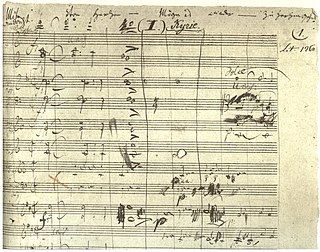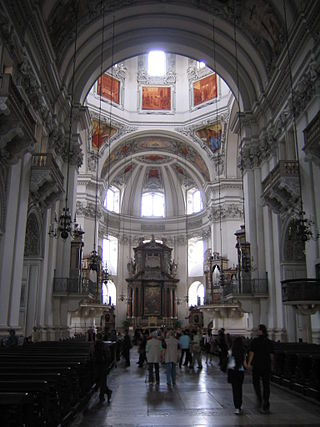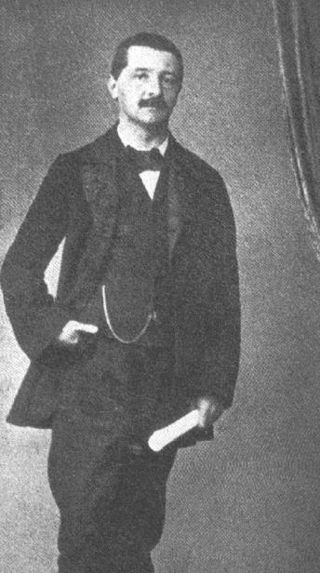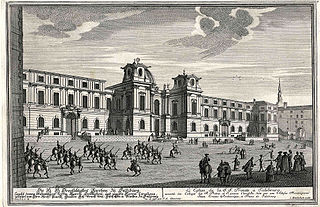
The Missa solemnis in D major, Op. 123, is a Solemn Mass composed by Ludwig van Beethoven from 1819 to 1823. It was first performed on 7 April 1824 in Saint Petersburg, Russia, under the auspices of Beethoven's patron Prince Nikolai Galitzin; an incomplete performance was given in Vienna on 7 May 1824, when the Kyrie, Credo, and Agnus Dei were conducted by the composer. It is generally considered one of the composer's supreme achievements and, along with Bach's Mass in B minor, one of the most significant Mass settings of the common practice period.

Great Mass in C minor, K. 427/417a, is the common name of the musical setting of the mass by Wolfgang Amadeus Mozart, which is considered one of his greatest works. He composed it in Vienna in 1782 and 1783, after his marriage, when he moved to Vienna from Salzburg. The large-scale work, a missa solemnis, is scored for two soprano soloists, a tenor and a bass, double chorus and large orchestra. It remained unfinished, missing large portions of the Credo and the complete Agnus Dei.

Missa in tempore belli is a setting of the mass by Joseph Haydn. It is catalogued Mass No. 10 in C major. Known also as the Paukenmesse due to the dramatic use of timpani, it is one of the most popular of his fourteen mass settings. The autograph manuscript contains the title "Missa in tempore belli" in Haydn's handwriting.

The Krönungsmesse, composed in 1779, is one of the most popular of Wolfgang Amadeus Mozart's 17 extant settings of the Ordinary of the Mass. It can be classified as either a Missa brevis or a Missa solemnis because although it includes all the sections of the Ordinary, it is relatively short.

Missa brevis usually refers to a mass composition that is short because part of the text of the Mass ordinary that is usually set to music in a full mass is left out, or because its execution time is relatively short.
The Mass No. 13 in B-flat major, Hob. XXII/13, was composed by Joseph Haydn in 1801. It is known as the Schöpfungsmesse or Creation Mass because of the words "qui tollis peccata mundi" in the Gloria. He recycled music from Adam and Eve's final duet in The Creation, a fact which scandalized Empress Maria Theresa so much that she ordered Haydn to recompose that passage for her own copy.

The Missa solemnis, WAB 29, is a solemn mass composed by Anton Bruckner in 1854 for the installation of Friedrich Mayer as abbot of St. Florian Abbey on 14 September 1854.

The Missa Sancti Bernardi von Offida is a mass in B-flat major by Joseph Haydn, Hob. XXII:10, Novello 1, was written the same year as the Missa in tempore belli (1796), and it "may have been the first mass Haydn wrote after his return from England." Yet it may also have been the second. It is usually given as Haydn's ninth setting of the mass, though its Hoboken number is XXII:10. This mass was written in honor of St. Bernard of Offida, a Capuchin monk who devoted himself to helping the poor; a century after the monk's death, he was beatified by Pope Pius VI.
The Harmoniemesse in B-flat major by Joseph Haydn, Hob. XXII:14, Novello 6, was written in 1802. It was Haydn's last major work. It is because of the prominence of the winds in this mass and "the German terminology for a kind of wind ensemble, Harmonie," that this mass setting is called "Harmoniemesse" or "Wind Band Mass". Besides flute, 2 oboes, 2 clarinets, 2 bassoons, 2 horns in B-flat, 2 trumpets in B-flat, the mass also calls for choir, timpani, strings, and organ, the latter supplying figured bass for most of the duration.

The Missa Cellensis in honorem Beatissimae Virginis Mariae in C major by Joseph Haydn, Hob. XXII:5, Novello 3, was originally written in 1766, after Haydn was promoted to Kapellmeister at Eszterháza following the death of Gregor Joseph Werner. The original title as it appears on the only surviving fragment of Haydn's autograph score, that has been discovered around 1970 in Budapest, clearly assigns the mass to the pilgrimage cult of Mariazell, Styria. Until that discovery, the work was known as Missa Sanctae Caeciliae, or in German Cäcilienmesse, a title probably attributed to the mass in the 19th century. Whether the alternative title refers to a performance of the piece by the St. Cecilia's Congregation, a Viennese musician's fraternity, on some St. Cecilia's day, as has been suggested, remains speculation.

The Missa brevis No. 9 in B-flat major by Wolfgang Amadeus Mozart, K. 275/272b, was probably written before September 1777 for Salzburg. The mass is scored for SATB soloists, SATB choir, violin I, violin II, 3 trombones, string bass, and organ.

The Missa brevis in G major, K. 140, K3 Anh. 235d, K6 Anh. C 1.12, was probably composed by Wolfgang Amadeus Mozart shortly after returning to Salzburg, in March 1773, from his third trip to Italy.

Michael Haydn wrote the Missa pro defuncto Archiepiscopo Sigismondo, or more generally Missa pro Defunctis, Klafsky I:8, MH 155, following the death of the Count Archbishop Sigismund von Schrattenbach in Salzburg in December 1771. Haydn completed the Requiem before the year was over, signing it "S[oli] D[eo] H[onor] et G[loria.] Salisburgi 31 Dicembre 1771." At the beginning of that year, his daughter Aloisia Josefa died. Historians believe "his own personal bereavement" motivated the composition. Contemporary materials which have survived to the present day include the autograph score found in Berlin, a set of copied parts with many corrections in Haydn's hand in Salzburg and another set at the Esterházy castle in Eisenstadt, and a score prepared by the Salzburg copyist Nikolaus Lang found in Munich.

The Sparrow Mass is a mass in C major K. 220/196b, Mass No. 9, Missa brevis No. 5, composed by Wolfgang Amadeus Mozart in 1775 or 1776 in Salzburg. The mass is sometimes termed a missa brevis et solemnis, because it is short in a simple structure as a missa brevis, but festively scored like a missa solemnis with brass and timpani in addition to four soloists, strings and organ. It was possibly first performed on 7 April 1776 in a mass for Easter at the Salzburg Cathedral. The nickname is derived from violin figures in the Hosanna which resemble bird chirping.

The St. Francis Mass is the shorter name for the Missa sub titulo Sancti Francisci Seraphici composed by Michael Haydn. He completed it on 16 August 1803, apparently at the request of Empress Maria Theresa for a name day celebration.

The Missa brevis No. 8 in C major, K. 259, is a mass composed by Wolfgang Amadeus Mozart in 1776. It is scored for SATB soloists, SATB choir, violin I and II, 2 oboes, 2 clarini, 3 trombones colla parte, timpani and basso continuo.

The Missa in honorem Sanctissimae Trinitatis in C major, K. 167, is a mass composed by Wolfgang Amadeus Mozart in June 1773. It is scored for SATB choir, violin I and II, 2 oboes, 2 clarini, 2 trumpets, timpani and basso continuo.

The Credo Mass in C major, K. 257, is a mass composed by Wolfgang Amadeus Mozart in 1776. It is scored for SATB soloists, SATB choir, violin I and II, 2 oboes, 2 clarini, 3 trombones colla parte and basso continuo.

The Missa brevis No. 7 in C major, K. 258, is a mass composed by Wolfgang Amadeus Mozart in 1776. It is scored for SATB soloists, SATB choir, violin I and II, 2 oboes, 2 clarini, 3 trombones colla parte, timpani and basso continuo.

The Missa longa in C major, K. 262/246a, is a mass composed by Wolfgang Amadeus Mozart in May 1776. Other sources claim it was composed in May 1775. It is scored for SATB soloists, SATB choir, violin I and II, 2 oboes, 2 horns, 2 clarini, 3 trombones colla parte, timpani and basso continuo.











